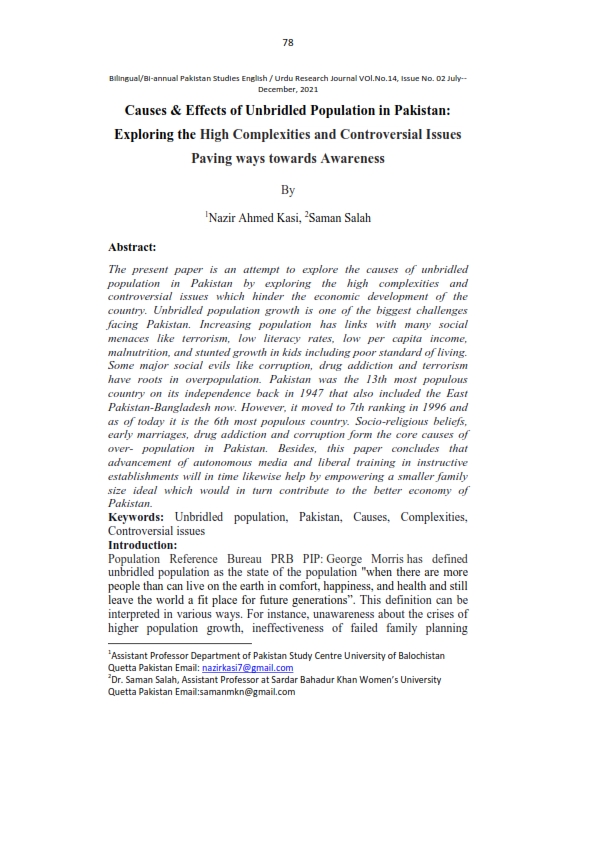Causes & Effects of Unbridled Population in Pakistan Exploring the High Complexities and Controversial Issues Paving ways towards Awareness
Keywords:
Unbridled population, Pakistan, Causes, Complexities, Controversial issuesAbstract
The present paper is an attempt to explore the causes of unbridled
population in Pakistan by exploring the high complexities and
controversial issues which hinder the economic development of the
country. Unbridled population growth is one of the biggest challenges
facing Pakistan. Increasing population has links with many social
menaces like terrorism, low literacy rates, low per capita income,
malnutrition, and stunted growth in kids including poor standard of living.
Some major social evils like corruption, drug addiction and terrorism
have roots in overpopulation. Pakistan was the 13th most populous
country on its independence back in 1947 that also included the East
Pakistan-Bangladesh now. However, it moved to 7th ranking in 1996 and
as of today it is the 6th most populous country. Socio-religious beliefs,
early marriages, drug addiction and corruption form the core causes of
over- population in Pakistan. Besides, this paper concludes that
advancement of autonomous media and liberal training in instructive
establishments will in time likewise help by empowering a smaller family
size ideal which would in turn contribute to the better economy of
Pakistan.
References
Ali, G. (2011). ―Climate Change Concerns and Emerging Challenges for
Water and Food Security of Pakistan.‖ Presentation made at the
Regional Workshop on Climate Change, Food and Water Security,
Colombo, SriLanka, 24–25 February, Retrieved from:
http://www.slideshare.net/globalwaterpartnership/8-g-ali-gwpiwmi-ws.
Ahmad, M., M. Iqbal, and M.A. Khan. (2013). ―Climate Change Brief:
Climate Change, Agriculture and Food Security in Pakistan:
Adaptation Options and Strategies.‖ Islamabad: Pakistan Institute
of Development Economics.
Ali, S., Y. Liu, M. Ishaq, T. Shah, A. Ilyas, and I. ud Din. (2017).
―Climate change and its impact on the yield of major food crops:
Evidence from Pakistan,‖ Foods 6(6): 1–19.
Ahsan. (2016) Over Population: Pakistan‘s Biggest Problem. Retrieved
from www.pulsepakistan.com
Baus, D. (2017). Overpopulation and the Impact on the Environment.
Retrieved from academicworks.cuny.edu
Ehrlich, P.R. (1968). The Population Bomb. New York: Ballantine Books.
Engelman, R., Y.G. Terefe, G. Gourmelon, J. Yang, J. Bish, J. Fanta, L.M.
Hunter, V. Markham, G. Kalema-Zikusoka, S. Sellers, and K.R.
Weiss. (2016). Family Planning and Environmental Sustainability:
Assessing the Science. Washington, DC: Wordwatch Institute
Global Peace Index, (2018). Retrieved from
http://visionofhumanity.org/app/uploads/2018/06/Global-Peace-Index2018-2.pdfRetrieved
Goujon, A., & Wazir, A. (2011). Human Capital and Population
Development: Pakistan and the› Cannon or Butter‹ Dilemma
«. Laurel J. Hummel/Richard L. Wolfel (Hg.), Understanding
Pakistan through Human and Environmental Systems, New York,
-182.
Hamilton, C. H. (1952). Davis: The Population of India and Pakistan
Edited by Charles E. Lively (Book Review). Rural
Sociology, 17(1), 382.
Imran, M. (2019). ―Pakistan‘s ground water level falling a meter every
year: The News. 22 March. Available at: https://www.
thenews.com.pk/print/447130-pakistan-s-ground-water-levelfalling-a-meter-every-year.
Rahul, (2013). Impact of population growth on the physical environment,
We School knowledge Builder, 11(1) July 2013”.Retrieved from
https://www.researchgate.net/publication/237771340_Impact of
Population Explosion on Environment.
khan, D. (2018). Overpopulation. A Major Factor of Socio-Economic
Problems in the Pakistani city Karachi. Food and Water Crisis
and the Climate Change Paperback – 13 March 2018.
Levin, J., & Bigsten, A. (2000). Growth, Income Distribution, and
Poverty: A Review. report nr.: Working Papers in Economics,
(32).
Lakhan, G. R. (2015). Population and Environment Relationship: An
Empirical Review with Respect to Pakistan. Population and
Environment, 6(5), 117-123.
Mahmood, Khalid. (2018). Seven Causes of Overpopulation in Pakistan.
Retrieved from https://www.shifa4u.com/blog/7-causes-ofoverpopulation-in-pakistan/21
Mittal, R., & Mittal, C. G. (2013). Impact of Population Explosion on
Environment. Retrieved from http://stec.univovidius.ro/html/anale/RO/wp-content/uploads/2019/08/20.pdf.
Ranis, G., Stewart, F., & Ramirez, A. (2000). Economic Growth and
Human Development. World Development, 28(2), 197-219.
Qasim, M. (2016). Pakistan Fails to Control Rapid Growth of Population.
Retrieved from The News. https./www.thenews.com.
Shaista. Bahar, Rozina. Khalid, Shehzad Ali Khan, Naseemullah &
Nazish. Batool. (2017). Challenges and Experiences of Lady
Health Workers Working in Polio Campaigns in District
Nowshera, Khyber Pakhtunkhwa, Pakistan. Pakistan Journal of
Public Health| Vol. 7, No. 2| June 2017.
Sathar, Z. A. (2012). Pakistan‘s Population Prospects, 2010–2030: A
Glass Half Full or Half Empty? In Population Dynamics in Muslim
Countries (pp. 79-95). Springer, Berlin, Heidelberg.
Uniyal, S., Paliwal, R., Kaphaliya, B., & Sharma, R. K. (2017). Human
Overpopulation: Impact on Environment. In Environmental Issues
Surrounding Human Overpopulation (pp. 1-11). IGI Global.
Zahid. Hussain, (2017). Exploding Population. Retrieved from
https../www.dawn.com.



